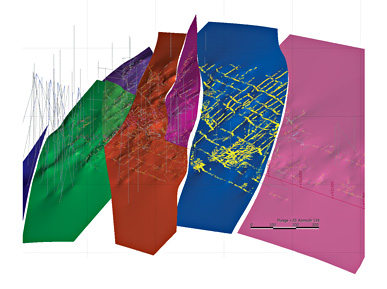To serve you better, our new website displays information specific to your location.
Please visit the site and bookmark it for future use.
You are here
SRK Kazakhstan ›Vein modelling using Leapfrog, leads into drillhole planning
Historically the modelling of narrow vein deposits has relied on classical two dimensional methods to estimate tonnage, grade and thickness in narrow vein deposits. The use of three dimensional models has been limited by complexity of this style of mineralisation leading to difficulties generating valid wireframes, associated with linking issues.
Recent developments in implicit software modelling enable geologists to model complex veins, dykes and individual strata with ease and speed directly from drill logs using Leapfrog’s interval selection tools in combination with advanced ‘vein’ modelling workflows.
The advantage of the software is that it provides reasonably quick interpretation, conducts active validation to avoid the classical issues of potential wireframe cross-overs, users can specify a minimum thickness and easily visualise variations in thickness of the veins.
To complete the process different approaches can be used to achieve the same goal from coding of the main vein domains in the geological database, to manual selection of intervals as an alternative to sectional interpretation. Guide strings allow further refinement to tie into potentially existing features such as underground development or stopes.
The selection of the mineralised intersections ensures accurate definition of hanging wall and footwall contact points with the “known” data in the sampling database, which can be extracted within Leapfrog Geo. Using the extracted datapoints, surfaces can be generated using predefined orientations or existing structural trends to model surfaces. Surfaces can be combined into a single solid with use of a minimum thickness to produce validated wireframes which can be exported to any Mining Estimation Software (such as Datamine/Vulcan) for use in the downstream workflow.
SRK has implemented this process on a number of projects which have enabled the clients to increase the understanding of grade/thickness relationships to more regional structural information, or interaction between veins in cases of epithermal systems which may have been missed using more traditional 2D methods.
Ben Parsons: bparsons@srk.com

Modelled narrow mesothermal vein system – Columbia 2013
|
You can download a PDF of the entire |
PDF
A4 |
PDF
Letter |
|
|
|
Our newsletters focus on specific areas of interest to earth resource professionals and clients. Each is available as an Adobe Acrobat PDF file. If you don't already have Adobe's PDF reader, you can download it free.

